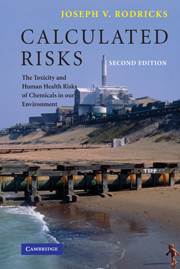Book contents
- Frontmatter
- Contents
- Preface to the first edition
- Preface to the second edition
- List of abbreviations
- Prologue
- 1 Chemicals and chemical exposures
- 2 From exposure to dose
- 3 From dose to toxic response
- 4 Toxic agents and their targets
- 5 Carcinogens
- 6 Identifying carcinogens
- 7 Risk assessment I: some concepts and principles
- 8 Risk assessment II: applications
- 9 Risk assessment III: new approaches, new problems
- 10 Risk assessment IV: the courtroom
- 11 The management of risk
- 12 A look ahead
- Sources and recommended reading
- Index
8 - Risk assessment II: applications
Published online by Cambridge University Press: 25 August 2009
- Frontmatter
- Contents
- Preface to the first edition
- Preface to the second edition
- List of abbreviations
- Prologue
- 1 Chemicals and chemical exposures
- 2 From exposure to dose
- 3 From dose to toxic response
- 4 Toxic agents and their targets
- 5 Carcinogens
- 6 Identifying carcinogens
- 7 Risk assessment I: some concepts and principles
- 8 Risk assessment II: applications
- 9 Risk assessment III: new approaches, new problems
- 10 Risk assessment IV: the courtroom
- 11 The management of risk
- 12 A look ahead
- Sources and recommended reading
- Index
Summary
I believe it was Mark Twain who quipped, when asked what he thought of the music of Richard Wagner, that “It's not as bad as it sounds.” Risk assessment might be similarly described.
Some risk assessors, in apparent disregard for the uncertainties associated with interspecies extrapolations and identifying dose–response relationships, have in recent years been making one announcement after another on the health risks associated with chemicals in the environment. “There is a one-in-one hundred thousand chance that ALAR will cause cancer in children consuming apple juice.” “Methylmercury contamination of seafoods leads to 80 000 cases each year of learning disabilities in children.” “Dioxin contamination of animal-based foods causes cancer in one of every 500 000 people.” The media offer such revelations with increasing frequency, usually accompanied by statements from regulatory agencies designed to quell public fears, remarks from manufacturers to the effect that risks have been greatly exaggerated, and professions of outrage from critics of both the regulatory and industrial communities.
It should be obvious by now that statements about risk of the type cited above, if standing alone, are misleading; if it is not obvious, it will be by the end of this chapter. There are no means available to identify these types of risk with the degree of certainty suggested by the language used. Perhaps the best a risk assessor might do, given today's knowledge, is a summary that goes something like this:
Difluoromuckone (DFM) has been found to increase the risk of cancer in several studies involving experimental animals. […]
- Type
- Chapter
- Information
- Calculated RisksThe Toxicity and Human Health Risks of Chemicals in our Environment, pp. 215 - 249Publisher: Cambridge University PressPrint publication year: 2006

